Blog Post: 400 Chernobyls: Solar Flares, EMP, and Nuclear...
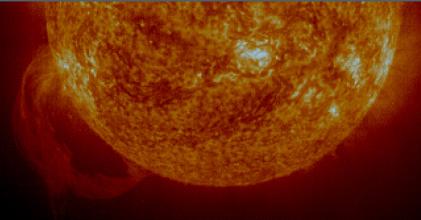
There are nearly 450 nuclear reactors in the world, with hundreds more either under construction or in the planning stages. There are 104 of these reactors in the USA and 195 in Europe. Imagine what havoc it would wreak on our civilization and the planet’s ecosystems if we were to suddenly witness not just one or two nuclear melt-downs but 400 or more! How likely is it that our world might experience an event that could ultimately cause hundreds of reactors to fail and melt down at approximately the same time? I venture to say that, unless we take significant protective measures, this apocalyptic scenario is not only possible but probable.
Consider the ongoing problems caused by three reactor core meltdowns, explosions, and breached containment vessels at Japan’s Fukushima Daiichi facility, and the subsequent health and environmental issues. Consider the millions of innocent victims that have already died or continue to suffer from horrific radiation-related health problems (“Chernobyl AIDS”, epidemic cancers, chronic fatigue, etc) resulting from the Chernobyl reactor explosions, fires, and fallout. If just two serious nuclear disasters, spaced 25 years apart, could cause such horrendous environmental catastrophes, it is hard to imagine how we could ever hope to recover from hundreds of similar nuclear incidents occurring simultaneously across the planet. Since more than one third of all Americans live within 50 miles of a nuclear power plant, this is a serious issue that should be given top priority![1]
In the past 152 years, Earth has been struck roughly 100 solar storms causing significant geomagnetic disturbances (GMD), two of which were powerful enough to rank as “extreme GMDs”. If an extreme GMD of such magnitude were to occur today, in all likelihood it would initiate a chain of events leading to catastrophic failures at the vast majority of our world’s nuclear reactors, quite similar to the disasters at both Chernobyl and Fukushima, but multiplied over 100 times. When massive solar flares launch a huge mass of highly charged plasma (a coronal mass ejection, or CME) directly towards Earth, colliding with our planet’s outer atmosphere and magnetosphere, the result is a significant geomagnetic disturbance.
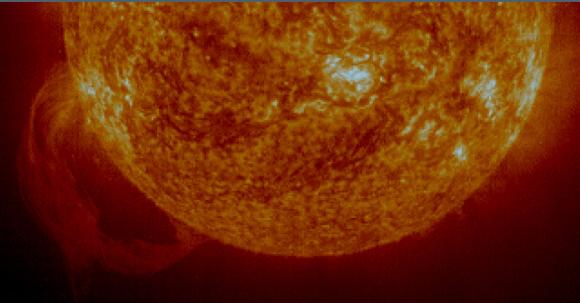
Coronal Mass Ejection (CME), SOHO image, June 9, 2002.
Since an extreme GMD of such a potentially disruptive magnitude that it would collapse the grid across most of the US last occurred in May of 1921, long before the advent of modern electronics, widespread electric power grids, and nuclear power plants, we are for the most part blissfully unaware of this threat and totally unprepared for its consequences. The good news is that relatively affordable equipment and processes could be installed to protect critical components in the electric power grid and its nuclear reactors, thereby averting this “end-of-the-world-as-we-know-it” scenario. The bad news is that even though panels of scientists and engineers have studied the problem, and the bi-partisan congressional EMP commission has presented a list of specific recommendations to congress, our leaders have yet to approve and implement a single significant preventative measure!
Most of us believe something like this could never happen, and if it could, certainly our “authorities” would do everything in their power to make sure they would prevent such an Apocalypse from ever taking place. Unfortunately, the opposite is true. “How could this happen?” you might ask. “Is this truly possible?” Read and weep, for you will soon know the answer.
Nuclear Power Plants and the Electric Power
Grid
Our global system of electrical power generation and distribution (“the grid”), upon which every facet of our modern life is utterly dependent, in its current form is extremely vulnerable to severe geomagnetic storms of a magnitude that tends to strike our planet on an average of approximately once every 70 to 100 years. We depend on this grid to maintain food production and distribution, telecommunications, Internet services, medical services, military defense, transportation, government, water treatment, sewage and garbage removal, refrigeration, oil refining and gas pumping, and to conduct all forms of commerce.
Unfortunately, the world’s nuclear power plants, as they are currently designed, are critically dependent upon maintaining connection to a functioning electrical grid, for all but relatively short periods of electrical blackouts, in order to keep their reactor cores continuously cooled so as to avoid catastrophic reactor core meltdowns and spent fuel rod storage pond fires.
If an extreme GMD were to cause widespread grid collapse (which it most certainly will), in as little as one or two hours after each nuclear reactor facility’s backup generators either fail to start, or run out of fuel, the reactor cores will start to melt down. After a few days without electricity to run the cooling system pumps, the water bath covering the spent fuel rods stored in “spent fuel ponds” will boil away, allowing the stored fuel rods to melt down and burn [2]. Since the Nuclear Regulatory Commission (NRC) currently mandates that only one week’s supply of backup generator fuel needs to be stored at each reactor site, it is likely that after we witness the spectacular night-time celestial light show from the next extreme GMD we will have about one week in which to prepare ourselves for Armageddon.
To do nothing is to behave like ostriches with our heads in the sand, blindly believing that “everything will be okay,” as our world inexorably drifts towards the next naturally recurring, 100% inevitable, super solar storm and resultant extreme GMD. The result of which in short order will end the industrialized world as we know it, incurring almost incalculable suffering, death, and environmental destruction on a scale not seen since the extinction of the dinosaurs some 65 million years ago.
The End of “The Grid” As We Know
It
There are records from the 1850s to today of roughly one hundred significant geomagnetic solar storms, two of which in the last 25 years were strong enough to cause millions of dollars worth of damage to key components that keep our modern grid powered. In March of 1989, a severe solar storm induced powerful electric currents in grid wiring that fried a main power transformer in the HydroQuebec system, causing a cascading grid failure that knocked out power to 6 million customers for nine hours while also damaging similar transformers in New Jersey and the United Kingdom. More recently, in 2003 a solar storm of lesser intensity, but longer duration, caused a blackout in Sweden and induced powerful currents in the South African grid that severely damaged or destroyed fourteen of their major power transformers, impairing commerce and comfort over major portions of that country as they were forced to resort to massive rolling blackouts that dragged on for many months[3].
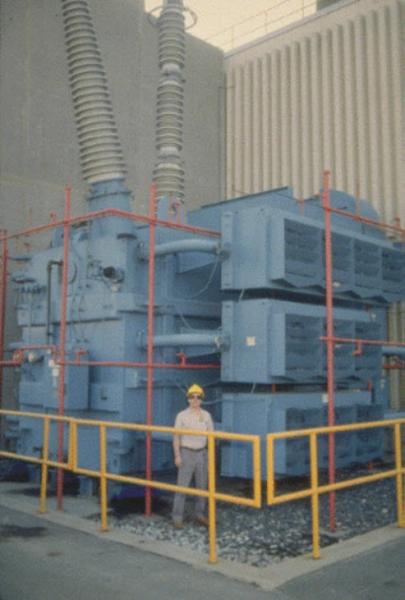
Transformer at the Salem Nuclear Plant, damaged by March 1989 solar storm[4].
During the Great Geomagnetic Storm of May 14-15, 1921, brilliant aurora displays were reported in the Northern Hemisphere as far south as Mexico and Puerto Rico, and in the Southern Hemisphere as far north as Samoa[5]. This extreme GMD produced ground currents roughly ten times as strong as the 1989 Quebec incident. Just 62 years earlier, the great granddaddy of recorded GMDs, referred to as “The Carrington Event,” raged from August 28 to September 4, 1859. This extreme GMD induced currents so powerful that telegraph lines, towers, and stations caught on fire at a number of locations around the world. Best estimates are that the Carrington Event was approximately 50% stronger than the Great Geomagnetic Storm of 1921[6]. Since we are headed into an active solar period, much like the one preceding the Carrington Event, scientists are concerned that conditions could be ripe for the next extreme GMD[7].
Prior to the advent of the microchip and modern extra-high-voltage (EHV) transformers (key grid components that were first introduced in the late 1960’s), most electrical systems were relatively robust and resistant to the effects of GMDs. Given the fact that a simple electrostatic spark can fry a microchip, and many thousands of miles of power lines act like giant antennas for capturing massive amounts of GMD spawned electromagnetic energy, the electrical systems of the modern world are far more vulnerable than their predecessors.
The federal government recently sponsored a detailed scientific study to more fully understand the extent to which critical components of our national electrical power grid might be effected by either a naturally occurring GMD or a man-made EMP. Under the auspices of the EMP Commission and the Federal Emergency Management Agency (FEMA), and reviewed in depth by the Oakridge National Laboratory and the National Academy of Sciences, Metatech corporation undertook extensive modeling and analysis of the potential effects of extreme geomagnetic storms upon the U.S. electrical power grid. Based upon a storm of intensity equal to the Great Geomagnetic Storm of 1921, Metatech estimated that within the US induced voltage and current spikes, combined with harmonic anomalies, would severely damage or destroy over 350 EHV power transformers critical to the functioning of the U.S. grid, and possibly well over 2000 EHV transformers worldwide.[4]
EHV transformers are custom designed for each installation and are made to order, weighing as much as 300 tons each, and costing well over US 1$ million each. Given the fact that there is currently a three year waiting list for a single EHV transformer (due to recent demand from China and India, the lead times have grown from one to three years), and that the total global manufacturing capacity is roughly 100 EHV transformers per year when the world’s manufacturing centers are functioning properly, you can begin to grasp the dire implications of this situation.
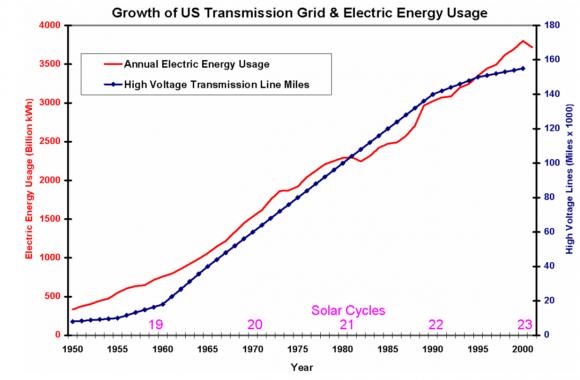
Growth of the US High Voltage Transmission Network and the Annual Electric Energy [4]
The loss of thousands of EHV transformers worldwide would cause a catastrophic collapse of the grid, stretching across much of the industrialized world. It will take years at best for the industrialized world to put itself back together after such an event, especially considering the fact that most of the manufacturing centers that make this equipment will also be grappling with widespread grid failure.
Our Nuclear “Achilles Heel”
"Five years ago I visited the still highly contaminated areas of Ukraine and the Belarus border where much of the radioactive plume from Chernobyl descended on 26 April 1986. I challenge chief scientist John Beddington and environmentalists like George Monbiot or any of the pundits now downplaying the risks of radiation to talk to the doctors, the scientists, the mothers, children and villagers who have been left with the consequences of a major nuclear accident. It was grim. We went from hospital to hospital and from one contaminated village to another. We found deformed and genetically mutated babies in the wards; pitifully sick children in the homes; adolescents with stunted growth and dwarf torsos; fetuses without thighs or fingers and villagers who told us every member of their family was sick. This was 20 years after the accident, but we heard of many unusual clusters of people with rare bone cancers…. Villages testified that ‘the Chernobyl necklace’—thyroid cancer—was so common as to be unremarkable."
— John Vidal, “Nuclear’s Green Cheerleaders Forget Chernobyl at Our Peril,” Guardian. co.uk, April 1, 2011[8]
So what do extended grid blackouts have to do with potential nuclear catastrophes? Nuclear power plants are designed to disconnect automatically from the grid in the event of a local power failure or major grid anomaly, and once disconnected they begin the process of shutting down the reactor's core. In the event of the loss of coolant flow to an active nuclear reactor's core, the reactor will start to melt down and fail catastrophically within a matter of a few hours at most. In an extreme GMD, nearly every reactor in the world could be affected.
It was a short-term cooling system failure that caused the partial reactor core melt-down in March 1979 at Three Mile Island, Pennsylvania. Similarly, according to Japanese authorities it was not direct damage from Japan’s 9.0 magnitude Tohoku Earthquake on March 11, 2011 that caused the Fukushima Daiichi nuclear reactor disaster, but the loss of electric power to the reactor’s cooling system pumps when the reactor’s backup batteries and diesel generators were wiped out by the ensuing tidal waves. In the hours and days after the tidal waves shuttered the cooling systems, the cores of reactors number 1, 2, and 3 were in full meltdown and released hydrogen gas, fueling explosions which breached several reactor containment vessels and blew the roof off the building housing the spent fuel storage pond of reactor number 4.
Of even greater danger and concern than the reactor cores themselves are the spent fuel rods stored in on-site cooling ponds. Lacking a permanent spent nuclear fuel storage facility, so-called “temporary” nuclear fuel containment ponds are features common to nearly all nuclear reactor facilities. They typically contain the accumulated spent fuel from 10 or more decommissioned reactor cores. Due to lack of a permanent repository, most of these fuel containment ponds are greatly overloaded and tightly packed beyond original design. They are generally surrounded by common light industrial buildings, with concrete walls and corrugated steel roofs. Unlike the active reactor cores, which are encased inside massive “containment vessels” with thick walls of concrete and steel, the buildings surrounding spent fuel rod storage ponds would do practically nothing to contain radioactive contaminants in the event of prolonged cooling system failures.
Since spent fuel ponds typically hold far greater quantities of highly radioactive material then the active nuclear reactors locked inside reinforced containment vessels, they clearly present far greater potential for the catastrophic spread of highly radioactive contaminants over huge swaths of land, polluting the environment for multiple generations spanning hundreds of years. A study by the Nuclear Regulatory Commission (NRC) determined that the “boil down time” for spent fuel rod containment ponds runs from between 4 and 22 days after loss of cooling system power before degenerating into a Fukushima-like situation, depending upon the type of nuclear reactor and how recently its latest batch of fuel rods had been decommissioned[9].
Reactor fuel rods have a protective zirconium cladding, which if superheated while exposed to air will burn with intense self-generating heat, much like a magnesium fire, releasing highly radioactive aerosols and smoke. According to Arnie Gundersen, former Senior Vice President for Nuclear Engineering Services Corporation, now turned nuclear whistle-blower, once a zirconium fire has started, due to its extreme temperatures and high degree of reactivity, contact with water will result in the water dissociating into hydrogen and oxygen gases, which will almost certainly lead to violent explosions. Gundersen says that once a zirconium fuel rod fire has started, the worst thing you could do is to try to quench the fire with water streams, since this action will only make matters worse and lead to violent explosions. Gundersen believes the massive explosion that blew the roof off the spent fuel pond at Fukushima was caused by zirconium induced hydrogen dissociation[10].
Had it not been for heroic efforts on the part of Japan’s nuclear workers to replenish waters in the spent fuel pool at Fukushima, those spent fuel rods would have melted down and ignited their zirconium cladding, which most likely would have released far more radioactive contamination than what came from the three reactor core melt-downs. Japanese officials have estimate that the Fukushima Daiichi nuclear disaster has already released into the local environment just over half the total radioactive contamination as was released by Chernobyl, but other sources estimate it could be significantly more than was released by the accident at Chernobyl. In the event that an extreme GMD induced long-term grid collapse covering much of the globe, if just half of the world’s spent fuel ponds were to boil off their water and become radioactive zirconium fed infernos, the ensuing contamination could far exceed the cumulative effect of 400 Chernobyls.
Electromagnetic Pulse (EMP) Attack
"Many of the control systems we considered achieved optimal connectivity through Ethernet cabling. EMP coupling of electrical transients to the cables proved to be an important vulnerability during threat illumination…. The testing and analysis indicate that the electronics could be expected to see roughly 100 to 700 ampere current transients on typical Ethernet cables. Effects noted in EMP testing occurred at the lower end of this scale. The bottom line observation at the end of the testing was that every system failed when exposed to the simulated EMP environment."
— Report of the Commission to Asses the Threat to the United States from Electromagnetic Pulse (EMP) Attack[11]
Electromagnetic pulses (EMPs) and solar super storms are two different, but related, categories of events that are often described as high-impact, low frequency (HILF) events. Events categorized as HILF don’t happen very often, but if and when they do they have the potential to severely affect the lives of many millions of people. Think of an EMP as a super-powerful radio wave capable of inducing damaging voltage spikes in electrical wires and electronic devices across vast geographical areas. (Note that the geomagnetic effects of solar storms are also described as “natural EMP”.)
What is generally referred to as an EMP strike is the deliberate detonation of a nuclear device at a high altitude, roughly defined as somewhere between 24 and 240 miles (40 and 400 kilometers) above the surface of the earth. Nuclear detonations of this type have the potential to cause serious damage to electronics and electrical power grids along their line of sight, covering huge distances on the order of a circular area 1,500 miles (2,500 kilometers) in diameter, which would correspond to an area stretching roughly from Quebec City in Canada down to Dallas, Texas.
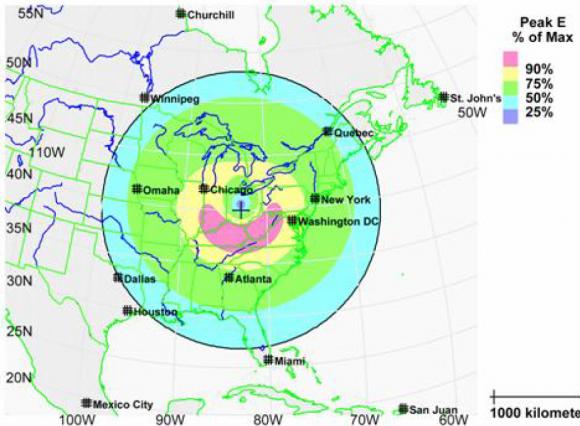
Illustrative EMP effects—Fast Pulse E1 Effects. [11]
The concern is that some rogue state or terrorist organization might build their own nuclear device from scratch or buy one illegally, procure a Scud missile (or similar) on the black market and launch their nuclear device from a large fishing boat or freighter somewhere off the coast of the US, causing grid collapse and widespread damage to electronic devices across roughly 50% of America. Much like an extreme GMD, a powerful EMP attack would also cause widespread grid collapse, but it would be limited to a much smaller geographical area.
A powerful EMP from a sub-orbital nuclear detonation would cause extreme electromagnetic effects, starting with an initial short duration “speed of light” pulse, referred to as an “E1” effect, followed by a middle duration pulse called an “E2” effect, which is followed by a longer duration disturbance known as an “E3” effect. The “E1” effect lasts on the order of a few nanoseconds, and is quite similar to massive discharges of electrostatic sparks, which are particularly damaging to digital microelectronic chips that are at the core of most modern electronic equipment.
The intermediate “E2” effects last a fraction of a second, and are similar to many thousands to millions of lightning strikes hitting over a widespread area at almost exactly the same time. In the case of a nuclear induced EMP, its E3 effect starts after about a half second and may continue for several minutes. The E3 effect can be thought of as a “long slow burn”, and electromagnetically it is quite similar to the effects from an extreme GMD, except that the latter may continue for a number of hours or days.
A “successful” EMP attack launched against the US would most likely result in the immediate collapse of the grid across roughly 50% of the country, crash the stock market, and cause critical failures in many of the electronic systems in affected areas that control nuclear reactors, chemical plants, telecommunications systems and industrial processes. These systems include programmable logic controllers (PLC), digital control systems (DCS), and supervisory control and data acquisition systems (SCADA).
The only good news about EMP strike is that its effect will cover a much smaller area than an extreme GMD, so there will be a significant portion of the rest of the US, as well as the rest of the outside world, left intact and able to lend a hand towards rebuilding critical infrastructure in the affected areas. Imagine the near total loss of a functioning infrastructure across an area of about a million square miles (approximately 1.6 million square kilometers, roughly equivalent to 50 Hurricane Katrinas happening simultaneously) and you will have some idea of the potentially crippling effect of an EMP attack from a single medium sized sub-orbital nuclear detonation!
Preventing Armageddon
The congressionally mandated EMP Commission has studied the threat of both EMP and extreme GMD events, and made recommendations to the US congress to implement protective devices and procedures to insure the survival of the grid and other critical infrastructures in either event. John Kappenman, author of the Metatech study, estimates that it would cost on the order of $1 billion to build special protective devices into the US grid to protect its EHV transformers from EMP or extreme GMD damage, and to build stores of critical replacement parts should some of these items be damaged or destroyed. Kappenman estimates that it would cost significantly less than $1 billion to store at least a year’s worth of diesel fuel for backup generators at each US nuclear facility and to store sets of critical spare parts, such as backup generators, inside EMP-hardened steel containers to be available for quick change-out in the event that any of these items were damaged by an EMP or GMD[12].
For the cost of a single B-2 bomber or a tiny fraction of the TARP bank bailout, we could invest in preventative measures to avert what might well become the end of our civilization and life as we know it! There is no way to protect against all possible effects from an extreme GMD or an EMP attack, but certainly we could implement measures to protect against the worst effects. Since 2008, Congress has narrowly failed to pass legislation that would implement at least some of the EMP Commission’s recommendations[13].
We have a long ways to go to make our world EMP and GMD safe. Every citizen can do their part to push for legislation to move towards this goal, and to work inside our homes and communities to develop local resilience and self reliance, so that in the event of a long term grid-down scenario, we might make the most of a bad situation. The same tools that are espoused by the “Transition Movement” for developing local self-reliance and resilience to help cope with the twin effects of climate change and peak oil could also serve communities well in the event of an EMP attack or extreme GMD. If our country were to implement safeguards to protect our grid and nuclear power plants from EMP, it would also eliminate the primary incentive for a terrorist to launch an EMP attack. The sooner we take these actions the less chance that an EMP attack will occur!
For more information, or to get involved, see http://empactamerica.org/, http://survive-emp.com/, and http://www.transitionnetwork.org/ or contact your congressman at http://www.contactingthecongress.org/.
NOTES:
[1] Bill Dedman, “Nuclear Neighbors: Population Rises Near Nuclear Reactors,” MSNBC.com. Available at http://www.msnbc.msn.com/id/42555888/ns/us_news-life/t/nuclear-neighbors-population-rises-near-us-reactors/#. Accessed December 2011.
[2] Dina Cappiello, “Long Blackouts Pose Risk to U.S. Nuclear Reactors,” Associated Press, March 29, 2011.
[3] Lawrence E. Joseph, “The Sun Also Surprises,” New York Times, August 15, 2010. Available at http://www.nytimes.com/2010/08/16/opinion/16joseph.html. Accessed August 2010.
[4] John Kappenman, “Geomagnetic Storms and Their Impacts on the U.S. Power Grid,” Metatech Corporation, prepared for Oak Ridge National Laboratory, Meta-R-319, January 2010, p. 2—29.
[5] S. M. Silverman and E. W. Cliver, “Low-Altitude Auroras: The Magnetic Storm of 14-15 May 1921,” Journal of Atmospheric and Solar-Terrestrial Physics 63, (2001), p. 523-535. Additionally, “High-Impact, Low-Frequency Event Risk to the North American Bulk Power System: A Jointly Commissioned Summary Report of the North American Electric Reliability Corporation and the U.S. Department of Energy’s November 2009 Workshop,” June, 2010, p. 68.
[6] Committee on the Societal and Economic Impacts of Severe Space Weather Events: A Workshop National Research Council, “Severe Space Weather Events: Understanding Societal and Economic Impacts Workshop Report,” National Research Council of the National Academies (2008), p. 7-13, and p. 100. Additionally, E. W. Cliver and L. Svalgaard, “The 1859 Solar-Terrestrial Disturbance and the Current Limits of Extreme Space Weather Activity,” Solar Physics (2004) 224, P. 407-422.
[7] Richard A. Lovett, “What if the Biggest Solar Storm on Record Happened Today?” National Geographic News, March 2, 2011. Available at http://news.nationalgeographic.com/news/2011/03/110302-solar-flares-sun-storms-earth-danger-carrington-event-science/. Accessed December 2011.
[8] John Vidal, “Nuclear’s Green Cheerleaders Forget Chernobyl at Our Peril,” Guardian.co.uk, April 1, 2011. Available at http://www.guardian.co.uk/commentisfree/2011/apr/01/fukushima-chernobyl-risks-radiation. Accessed May 2011.
[9] NUREG-1738, “Technical Study of Spent Fuel Pool Accident Risk at Decommissioning Nuclear Power Plants,” February 2001, as reported in “Petition for Rulemaking: Docket No. PRM-50-96,” Foundation for Resilient Societies before the Nuclear Regulatory Commission, p. 3-9 and 49-50. Available at http://www.resilientsocieties.org/images/Petition_For_Rulemaking_Resilie.... Accessed December, 2011.
[10] Arnold Gundersen, interview by author, November 2011.
[11] “Report of the Commission to Assess the Threat to the United States from Electromagnetic Pulse (EMP) Attack: Critical National Infrastructures,” April, 2008, p. 6.
[12] John Kappenman, interview by author, December 2011.
[13] Dr. Peter Vincent Pry, “Statement Before the Congressional Caucus on EMP,” EMPact America, February 15, 2011. Available at http://www.empactamerica.org/pry-statement-to-emp-caucus.pdf. Accessed November 2011.
About the author: Matthew Stein is a design engineer, green builder, and author of two bestselling books: When Disaster Strikes: A Comprehensive Guide to Emergency Planning and Crisis Survival (Chelsea Green 2011), and When Technology Fails: A Manual for Self-Reliance, Sustainability, and Surviving the Long Emergency (Chelsea Green 2008). Stein is a graduate of the Massachusetts Institute of Technology (MIT) where he majored in Mechanical Engineering. Stein has appeared on numerous radio and television programs and is a repeat guest on Fox News, Lionel, Coast-to-Coast AM, and the Thom Hartmann Show. He is an active mountain climber, serves as a guide and instructor for blind skiers, has written several articles on the subject of sustainable living, and is a guest columnist for the Huffington Post.
Category:


































